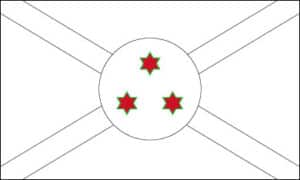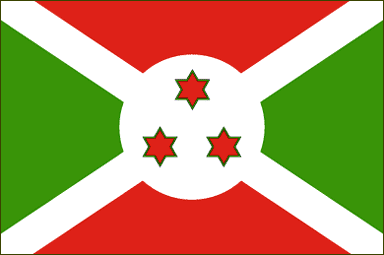
The red and green elements of the field are alternated in the Burundian national flag’s white saltire. Three red solid six-pointed stars with green outlines are shown on a white disc in the saltire’s centre.
These three stars, which stand for the national mottos of Burundi (which is “Unity, Work, and Progress”), are arranged in a triangle. Additionally, the Hutu, Tutsi, and Twa ethnic groupings are represented by the stars. Green symbolises hope and optimism, white symbolises peace, and crimson represents the sacrifices made by the warriors during the war for independence. The flag has a 3:5 ratio.
Facts about the Burundi flag |
| Country | Burundi |
|---|---|
| Designed by | NA |
| Adopted | June 28, 1967 |
| Revision | 1961, 1962, 1966, 1967, 1982 |
| Design and Colors | A white saltire on a red and green field with a white disk, consisting of three red solid six-pointed stars outlined in green, being in the center. |
| Size Ratio | 3:5 |
| Official Name: | Republic of Burundi |
| Proportion: | 3:5 |
| Adopted on: | March 28, 1967 |
| Location: | The Republic of Burundi is bordered by Rwanda, Tanzania, and the Democratic Republic of the Congo |
| Capital City: | Gitega |
| Major Cities: | Bubanza, Bujumbura Mairie, Karuzi |
| Area: | 10,745 square miles |
| Population: | 10,216,190 |
| Currency: | Burundi franc (FBu) (BIF) |
| Official Languages: | French, Kirundi |
| National Anthem: | Our Burundi |
| National symbol(s): | lion |
| National colors: | red, white, green |
| National anthem: | |
| Name: | “Burundi Bwacu” (Our Beloved Burundi) |
| Lyrics/Music: | Jean-Baptiste NTAHOKAJA/Marc BARENGAYABO |
Historical Background
The current design of the Burundi flag was officially adopted on March 28, 1967, following Burundi’s independence from Belgian colonial rule. The flag’s design was inspired by the country’s historical and cultural elements, with the aim of creating a symbol of a new, independent Burundi.
Design and Colors
The Burundi flag features a field of divided bands of white, red, and green, with a white circle and three red stars in the center. The white band is at the top, followed by the red band in the middle, and the green band at the bottom.
Symbolism of the Burundi Flag
Each element of the Burundi flag holds significant symbolism. The white color represents peace, symbolizing Burundi’s aspiration for a peaceful and harmonious society. The red color represents the struggle for independence and the sacrifice made by the Burundian people for their freedom.
The green color symbolizes hope, renewal, and prosperity for the nation’s future. The white circle in the center represents unity and harmony among Burundi’s diverse population. The three red stars inside the white circle represent the three main ethnic groups of Burundi: the Hutu, the Tutsi, and the Twa, as well as the principles of liberty, equality, and fraternity.
Burundi Independence Day
Burundi Independence Day is celebrated on July 1st each year, commemorating the day in 1962 when Burundi gained independence from Belgian colonial rule. This day is marked by various celebrations, parades, and flag-raising ceremonies, showcasing the importance of the Burundi flag as a symbol of independence and national identity.
FAQs
Q1: When was the current design of the Burundi flag adopted?
The current design of the Burundi flag was officially adopted on March 28, 1967.
Q2: What do the colors on the Burundi flag represent?
The white color represents peace, the red represents the struggle for independence, and the green represents hope and prosperity.
Q3: What is the significance of the white circle and red stars on the Burundi flag?
The white circle represents unity among Burundi’s diverse population, and the three red stars represent the three main ethnic groups of Burundi: the Hutu, the Tutsi, and the Twa, as well as the principles of liberty, equality, and fraternity.
Q4: How should the Burundi flag be handled and displayed?
The Burundi flag should be treated with respect and dignity. Proper protocol should be followed when hoisting, lowering, and displaying the flag to ensure it is treated with the importance it deserves.
Q5: When is Burundi Independence Day?
Burundi Independence Day is celebrated on July 1st each year, commemorating the day in 1962 when Burundi gained independence from Belgian colonial rule. It is an occasion for celebrations, parades, and flag-raising ceremonies, showcasing the importance of the Burundi flag as a symbol of independence and national identity.

